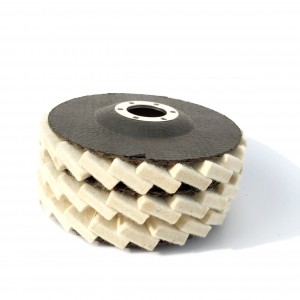Wool felt wheels have emerged as a transformative force in a wide range of industries, thanks to their exceptional versatility and effectiveness in polishing and finishing tasks. From large – scale industrial operations to intricate artisanal work, these unassuming wheels are making a significant impact on the quality and efficiency of various processes.
In the automotive industry, wool felt wheels are an integral part of the manufacturing and detailing processes. During automotive manufacturing, wool felt wheels are used to polish metal components, such as engine parts, exhaust systems, and trim pieces. The ability of wool felt wheels to provide a high – quality finish not only enhances the aesthetic appeal of the vehicle but also improves the durability and corrosion resistance of the components. In automotive detailing, wool felt wheels are indispensable for paint correction and surface restoration. They can effectively remove oxidation, scratches, and swirl marks from the vehicle’s paint, leaving it with a showroom – quality shine. This is crucial for both new car sales, where a perfect finish can enhance the perceived value of the vehicle, and for the used car market, where a well – polished car can command a higher price.
The jewelry industry also benefits greatly from the use of wool felt wheels. Jewelers rely on these wheels to polish precious metals like gold, silver, and platinum, as well as gemstones. Wool felt wheels can create a smooth, reflective surface on metals, bringing out their natural luster and beauty. When it comes to gemstones, the gentle yet effective polishing action of wool felt wheels ensures that the stones’ facets are enhanced without causing any damage. This is essential for creating high – end jewelry pieces that are both visually stunning and of the highest quality. Moreover, wax – impregnated wool felt wheels are particularly useful in the jewelry industry, as they simplify the polishing process and ensure a consistent finish across multiple pieces.
In the woodworking industry, wool felt wheels play a vital role in wood finishing. Whether it’s for furniture manufacturing, cabinetry, or musical instrument production, wool felt wheels are used to apply finishes such as stains, varnishes, and oils evenly and smoothly. They can also be used to buff the wood surface to a high gloss, giving the finished product a professional look. In the case of musical instruments, a proper finish achieved with wool felt wheels can not only enhance the instrument’s appearance but also affect its acoustic properties. For example, a well – polished guitar body can contribute to better sound projection.
The electronics industry also makes use of wool felt wheels for polishing and finishing electronic components. As electronics become smaller and more complex, the need for precise polishing of components such as casings, connectors, and circuit boards has increased. Wool felt wheels can be used to achieve a smooth surface finish, which is important for both the functionality and aesthetics of electronic devices. Additionally, in the restoration of vintage electronics, wool felt wheels can be used to carefully clean and polish the components, bringing them back to their former glory.
Even in the sports equipment and outdoor gear industries, wool felt wheels are finding their place. For example, in the production of golf clubs, wool felt wheels can be used to polish the club heads for better aerodynamics and a more appealing look. In the case of bicycles, wool felt wheels can be used to refinish the frames, giving them a new lease on life. For outdoor gear such as camping gear and hiking equipment, wool felt wheels can be used for maintenance and restoration, ensuring that the products remain in top condition for years to come.
In conclusion, the versatility of wool felt wheels has allowed them to become an essential tool in numerous industries. As technology continues to advance and new applications are discovered, it is likely that wool felt wheels will continue to play a crucial role in transforming and enhancing various manufacturing and finishing processes across different sectors.

Post time: Jun-13-2025
